Statistical Accounts of Cortachy & Clova
The Old or First Statistical Account of the parish of Cortachy and Clova is dated 1794 whilst the New Account is dated 1842.
UNITED PARISHES OF CORTACHY AND CLOVA.
(County and Presbytery of Forfar.—Synod of Angus and Mearns.)
By Mr William Haldane, Preacher of the Gospe1.
Name, Situation, and Extent.
CORTACHY, or Quartachy, is derived from the Gaelic word chuartaich, which signifies enclosed or surrounded. The name is descriptive of its local situation, as it lies in a small valley, surrounded by rising ground. The origin of the name Clova is uncertain. These united parishes lie on the north side of the county of Angus. The river Prosen separates them from the parishes of Kingoldrum and Kirriemuir, on the S. and S. W. The parish of Cortachy, from the extreme part on the south to its northern boundary on the Grampian hills, is about 13 miles in length. Its breadth varies. The north and middle parts are about 8 miles broad. Towards the south end, its breadth does not exceed two miles. The parish of Clova is situated on the northwest of Cortachy, and forms part of the Grampian mountains. It is about 10 miles long, from E. to W. and 7 broad. There is no map of the parish; nor has the number of acres been ascertained.
Soil and Surface.—The soil of these united parishes is in general poor, upon a cold and wettish bottom. The haugh ground, on the banks of the Esk, is an open light soil, in many places interspersed with, or bordering on, peat moss. The greatest part of these parishes is mountainous, and calculated only for pasture. The hills in Cortachy are chiefly covered with heath, with a small mixture of rough grass along their sides. Those in Clova are, in general, green, producing excellent grass, and well adapted for sheep. In some places the hills are sleep and rocky, and almost all of them abound with large whin-stone.
Climate and Diseases.—The air is sharp and piercing, particularly on the high grounds. That part of the united parishes, which is situated among the Grampian hills, is, in winter, generally covered with snow to a great depth, which often is not all dissolved before the months of June and July. The climate is favourable to health, and many of the inhabitants live to the age of 70 and 80 years. The most prevalent distempers are rheumatism and levers, which are probably occasioned by the variations of the weather.
River, Lakes, and Fish.—The only river in the united parishes is the Esk. Originating among the Grampian hills, it passes through both parishes; and, after traversing a course of 16 miles to the eastward, empties itself into the sea at Montrose. It produces plenty of small trouts, but very few salmon; the latter being prevented from coming up by the number of cruives in the way. The only lakes deserving notice are Loch Brandy in the parish of Clova, and Loch Churl in the parish of Cortachy. They are situated on the north side of the Esk, nigh the summit of the Grampian hills, and are distant about 2 miles from each other. On the north side they are bounded by a steep rock, and on the south they have outlets which communicate with the river below. Their form is circular, and they are about a mile and a half in circumference. These lakes abound with trouts of various sizes.
Hills.—The hills in these parishes are of a very considerable height, particularly those in Clova, which form part of the Grampians. They are partly conical, and partly almost perpendicular. The most romantic are those situated on the south-east end of the parish of Clova, and which, on the north and south side, encompass a beautiful valley about 4 miles in length, and half a mile in breadth. Here the stupendous height of the mountain, contrasted with the delightful narrow plain below, exhibits a scene of grandeur and beauty united.
Quadrupeds and Birds.—The number of horses is about 400, and of black cattle 1200. The horses and cattle are generally of a small size. A horse of 5 years old brings, in the market, from 7l. to 10l. Sterling; a cow or ox, of 4 years old, from 4l. to 6l. The number of sheep may be about 8000 in summer, but fewer in winter. They are mostly of the black faced kind, bought, when a year old, in the Linton markets, in the months of June and July, and kept for four years. They are sold fat about Martinmas, to butchers, at the neighbouring markets. They bring from 12s. to 16s. ahead. There are also white-faced sheep, but of a smaller size than the former. The number of swine in the parish is very smal1. The wild quadrupeds are deers, hares, and foxes. Of the winged tribe there are, besides tame fowl, muir fowl, wild ducks, partridges, and tarmacks.
Agriculture.—Almost the only cultivated part of these united parishes, except what lies on the southern extremity, is that lying along the banks of the Esk, about 14 miles long and half a mile broad. The rest is hilly, or laid out for pasture. Considerable improvement of late has been made in agriculture, particularly in the lower part of the parish of Cortachy. Here the farmer observes a proper rotation in cropping; and the fields, after 3 years tillage, are sown out with grass seeds for 4 years. In the middle and upper districts of these united parishes, where sheep and cattle are the staple commodity, improvement in agriculture is not so much attended to; nor is the climate so favourable for raising corn as in the lower parts. If here the farmer can raise as much grain as will suffice for meal and seed, he seldom seeks farther, and trusts to his profits from sheep and cattle to pay his rents. The only manure on the parish is that which is made by the cattle on the farms. Some farmers, for the sake of improvement, drive marl from the loch of Kinordy, in the parish of Kirriemuir, which is about three miles distant from the southern boundary of the parish of Cortachy. Such of the farmers in the parish as can procure marl, are enabled to bring their farms into a state of high cultivation, and to raise excellent crops; but this species of manure can only be acquired by a few of them, by reason of their great distance from it.
The English plough has lately been introduced here; but that chiefly used is the Scotch plough. The harrow and cart used are of the common construction; the latter generally drawn by two horses. A good plough costs from 40s. to 50s.; a cart from 6l. to 7l.; and a harrow about 10s. (A ploughman, maintained in the family, receives, for wages, from 6l. to 8l. per annum. A labouring man, hired per day, receives from 8d. to 10d. with victuals; and if hired during the harvest season, he earns from 20s. to 25s. A mason, per day, gets from 18d. to 20d. and maintains himself. A tay!or receives 8d. with his maintainance; a maid servant, 3l.. per annum; and a carpenter, including victuals, 1s. per day.
Crops, Seed-time, & Harvest.—These united parishes produce oats, barley, pease, flax, and potatoes. Turnips, white and red clover and rye-grass, are seldom sown, except in the vicinity of Cortachy, which lies on the southern extremity of the parish. The time of sowing oats generally commences about the 24th of March, and ends about the 24th of April. Barley sowing; begins about the 8th of May, and ends about the 24th. Harvest is generally begun about the middle of September, and concluded by the first of November. There is little grain exported from this parish even in the most fruitful seasons. The crops are seldom sufficient to support the inhabitants; and often the farmers, in the upper districts, are under the necessity of buying feed corn. Here the principal dependence of the farmer is on his sheep and cattle. (The value of grain and provisions is very much regulated by the prices given in Kirriemuir, the nearest market town to this united parish. Their value also is according to their plenty or scarcity, but, on an average, the following may be considered as the prices of grain and provisions in this parish. Hay brings from 5d. to 7d. per stone, barley from 15s. to 16s. per boll, and oats from 13s. to 15s. A stone of flax gives from 10s. to 13s.; pease, from 13s. to 14s. per boll; potatoes, from 5s. to 6s. The average price of beet and mutton is 3d. per lib. cheese 4d. butter 9d.; the last two articles have 27 ounces to the pound weight. A hen is sold at 10. a chicken at 3d. and a duck at 7d.
Wood, Fuel, and Minerals.—The only natural wood in the parish is allar, birch, hazel, and willow, which are to be found, in a few places, in small clumps along the banks of the Esk. There is only one fir plantation, deserving notice, lying near the southern extremity of the parish of Cortachy. Around the Castle of Cortachy, one of the seats of the Earl of Airley, there are various kinds of forest trees, as ash, elm, larch, plain, beech, &c. Adjoining the Castle, there is a large garden, abounding with several species of fruit trees, besides a hot-house for peach, nectarine, and vine trees. There are several mosses in the united parishes, most of them situated near the summit of the hills. Peats, turf, and heath, are the principal fuel. The only stone here, found sit for building, is whin-stone; but it cannot be dressed with an iron.
Population, &c.—The number of the inhabitants has decreased nearly a sixth part, within these 40 years. (This decrease has been chiefly owing to the thriving state of manufactures in the several cities and villages of the county, and to the higher wages given in the more inland parts.)
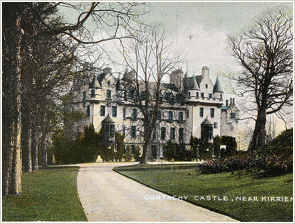
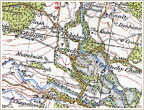
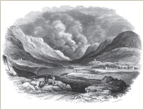
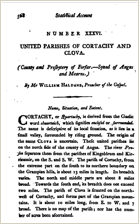
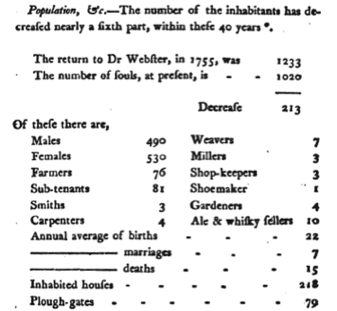
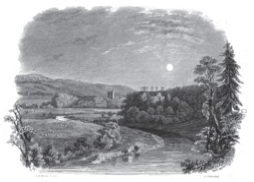
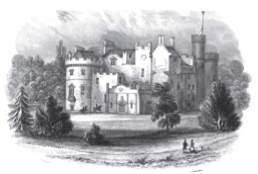
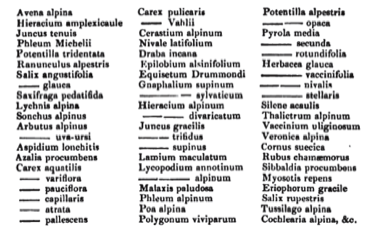

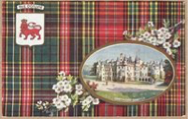
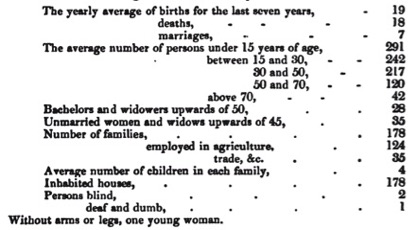


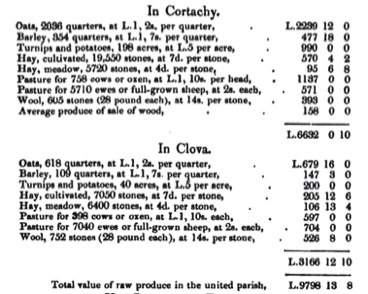
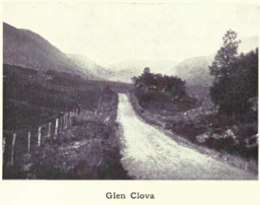
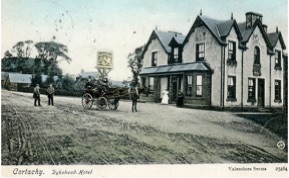
V.—PAROCHIAL ECONOMY.
The nearest market-town is Kirriemuir, which is distant from the people in the southern part of the parish about four miles, and from those in the northern part of it about eighteen miles. The means of communication are, the post-office at Kirriemuir, and the roads (none of which are turnpike) leading in different directions to and from the parish. The alteration of the direction of some of the lines of road is a great improvement, which has been effected in the course of the last twenty years. The roads in general are of a proper breadth. They have been well formed, and are kept in a proper state of repair. The line of road leading to Strathmore extends the whole length of the inhabited portion of the united parish. Several miles of this road are now in excellent order, and the improvements which have recently been made on it will doubtless, from the good effects resulting from them, afford encouragement to all parties concerned to use their endeavours to render this road good, even to its northern boundary. There is no carriage road from Clova across the mountains to Deeside. A survey was made some years ago of a line of road to extend over the Cappel Mount. This line, (to carry which into effect, has been considered, by an experienced surveyor, quite practicable,) would afford the means of easy communication between the people in this county and those in the upper districts of Aberdeenshire.
Bridges.—The two principal bridges connected with the parish are those across the Southesk and Prosen rivers,—the former, near to the church of Cortachy, has only one arch. It is narrow, like most old bridges, of excellent workmanship, and romantically situated. The latter crosses the Prosen, on the line of road leading to Strathmore. It was widened some years ago, and has been substantially built. There are several smaller bridges on different lines of road throughout the parish, which are in good repair. There is also a neat suspension bridge across the Southesk river, opposite to the church of Clova, for foot-passengers, and also for horses when the ford below becomes impassable.
Ecclesiastical State.—The church of Cortachy is placed nearly at the southern extremity of the parish, and consequently is not conveniently situated for the greater part of the population. It was built in 1828-29, on the site of the former church. It is an elegant building. The internal work has been very tastefully executed. It is sufficiently large, affording accommodation for 550 persons, and it is delightfully situated. It was built at the expense of the Earl of Airlie, and cost considerably upwards of L.2000. The sittings in the church are all free, that is, the heritors receive no money for them; they are divided amongst the farmers and the other householders in the parish. The manse was built in 1796; it was partially repaired a few years ago. It is sufficiently large and comfortable. The extent of the glebe is about ten acres, and its annual value about L.15. The amount of the stipend is 15 chalders, the one-half oatmeal, the other barley, and L.8, 6s. 8d. for communion elements.
The church of Clova is about ten miles distant from the church of Cortachy. It is not known when it was built. There was a gallery erected in the west end of it in 1731; but, from the appearance of the building, and from statements contained in the parochial registers, it is probable that the church had been long built before the gallery was erected. The seats in the church of Clova were lately renewed, and the church is in good repair. It is conveniently situated for the population of Clova, and of the northern district of Cortachy. It affords accommodation for about 250 persons. The sittings are all free, with the exception of those in the gallery, which are let for the benefit of the poor.
There was a suitable and comfortable house erected in Clova about twenty-four years ago by the Noble family of Airlie, for the accommodation of a missionary minister on the Royal Bounty. That house is still kept in good repair by the present honourable proprietor of Clova. In addition to the mission house, the minister receives as much arable land, free of rent, as enables him to keep a cow and pony, summer and winter. The farmers within the bounds of the mission plough his land and drive his fuel. The minister officiates alternately in the church of Clova, and in the chapel of Glenprosen, connected with the parish of Kirriemuir, besides performing among the people within the bounds of the mission all the other duties connected with the office of the holy ministry. He receives annually L.30 from the Committee on the Royal Bounty, L.30 from the people connected with the mission, and 20 guineas from the Earl of Airlie. All the families in the united parish belong to the Established Church, with the exception of the Noble family of Airlie, the members of which are Episcopalians. There are three individuals belonging to other families who are also Episcopalians. Divine service at the churches of Cortachy and Clova is generally very well attended. The average number of communicants is about 530; of these about 180 communicate at Clova, and 350 at Cortachy. The average amount of church collections annually for religious and charitable purposes may be L.12.
Education.—There are four schools in the parish at the present time; the parochial, and three unendowed schools. The number of scholars attending them is 130. There are, besides, about 20 girls, who attend a female school, which, although not in the parish, is in its immediate neighbourhood. The unendowed schools are kept only during the winter season; one of them is placed beside the mission house in Clova, and is taught by a young man, who is engaged and directed in his mode of teaching by the minister. The number of scholars is 48, and the branches taught are, reading, writing, and arithmetic; the other two unendowed schools in Cortachy are supported by the parents, or other relatives of the young persons who attend them. The teachers receive a certain allowance in money for the time they are engaged, besides board and lodging. The number of scholars at these schools is 46; they are taught the ordinary branches of instruction. The parochial school, which is situated near to the southern extremity of the parish, is attended by 38 scholars. The branches generally taught are, reading, writing, arithmetic, English grammar, book-keeping, geography, and Latin. The salary is the maximum,—L.34, 4s. 4d. The annual amount of school fees is about L.10.
Library.—There is one parochial library, which contains upwards of 200 volumes. With the exception of some volumes of history, geography, and travels, the books consist chiefly of religious publications. The library has been in a great measure supported by donations of books, and of money with which to purchase books, from the Noble family of Airlie. Several of the books were selected and given by the late Countess of Airlie, who took a great interest in promoting the temporal and spiritual good of the young and rising generation in this parish and neighbourhood.
Poor and Parochial Funds.—The average number of persons receiving regular parochial aid is, 11 in Cortachy and 2 in Clova; the sum allotted to each varies from 3s. to 12s. per month. The collections made at the church of Clova are sufficient for the relief of the poor in that portion of the united parish. The annual expenditure for the poor in Cortachy is about L.42. The annual amount of the poor's funds, on an average of the last five years, is L.50, 16s., arising as follows: from church collections and mortcloth dues, L.42, 16s.; interest of money in the bank, L.4, 10s.; interest of mortified money, L.4. The amount of mortified money is L.100, which was left by the late Mr Alexander Robie at Inveriskandy, who was a native of, and a farmer in, this parish; the interest of this sum, according to directions left by the donor, is annually distributed amongst the poor belonging to a certain district of the parish; the minister and elders of the parish, and the heads of families in the specified district are appointed trustees. The wants and comfort of the poor are particularly attended to by the Noble family of Airlie. The disposition among the poor in general to refrain from seeking parochial relief is very powerful.
Fairs.—There are two sheep-markets held annually at Cortachy, commonly called the Collow markets, as they are held in the immediate neighbourhood of a farm of that name. The first established of these markets is held on the fourth Monday of October, and has become one of the best sheep markets in the north of Scotland, both for the number and quality of the sheep which are there exposed; the number being on an average from 8000 to 12,000. The sheep brought to this market are generally three or four years old, and are purchased by proprietors or farmers in this and the adjoining counties, who feed them off during the winter with turnips and hay or straw. The latest established of these markets is held on the last Friday of April. The stock exhibited consists chiefly of hogs, or one year old sheep, and as it is much approved of by the store-farmers in this district, it has been, and will, doubtless, continue to be, well supported. The grounds where the above markets are held, are not only most conveniently situated for the flocks as they descend from the mountains, but ample space is afforded for their convenience, and for preventing them, when properly attended to, from mixing together.
Inns, Alehouses.—There is a convenient and well kept inn at Clova, which was erected only a few years ago, and which is much frequented by travellers in summer. There are five ale-houses in Cortachy; to reduce their number might be injurious to the support of those who keep them; but it could not fail to be beneficial to the morals of some of the people.
Fuel.—Peat and turf are commonly used as fuel by the families in the northern districts of the parish. Peat is obtained from the mossy grounds in the hollows, either on the sides, or towards the summits of the mountains. In these hollows, the moss is almost inexhaustible, and of superior quality. Much time and labour are employed by the people in summer, in cutting, drying, and conveying the peat to their several dwelling-places, which are generally from two to six miles distant from the mosses. Peat and turf are partially used by most of the families in the southern part of the parish; they also use quantities of brushwood, which are obtained by purchase, from the woods in the parish and neighbourhood. Some of the families, in this part of the parish, make use of coals chiefly for fuel. The coals are brought either from Dundee, or from the depot connected with the railway at Newtyle. Several of the farmers have been in the practice, for some years past, of bringing home a certain quantity of coals during summer, to be used as fuel in winter. This is a wise provision, although, in ordinary dry seasons, peat may be safely got home, and makes very good fuel; yet, when the summers are unusually rainy, it is. not sufficiently dried to be fit for burning, which is the cause of no ordinary suffering to those families which depend entirely on peat for fuel during the winter. It is highly probable, that coals will soon be more generally used for fuel than they have hitherto been in the parish.
September 1842.
The kinds of trees generally planted are, larch, Scots fir, spruce, white and black American, silver fir, Weymouth pine, pinasters, oak, elm, ash, mountain-ash, plane, beech, chestnuts, birch, alder, and shrubs.
The yearly thinning and pruning of the woods are particularly attended to, and under excellent management. A report on the planting of lands on the Airlie estates, to the extent of 3000 acres, in Forfarshire and Perthshire, under the management of Mr William Anderson, was submitted to the Highland Society of Scotland in 1830; and the Society's gold medal was adjudged to the Earl of Airlie. (Quarterly Journal of Agriculture, No. xii. February 1881.) In no other parish has there yet been such an extent of land planted as in the parish of Cortachy, on the estates of Airlie.
Rent, &c.—The average rent of arable land in the united parish may be from 15s. to L.1. The average rent of grazing, per ox or cow, is L.1, 10s. The average rent of pasture, for ewe or full-grown sheep for the year, is 2s.
Price of Raw Produce.—The average price of barley per imperial quarter for the last seven years, has been L.1, 7s.; oats, per imperial quarter, L.1, 2s.; potatoes, per boll of 32 stones, 9s.; hay, per stone, from 7d. to 8d.
Live-Stock.—The cattle reared in the united parish are chiefly of the Angus breed. They are of middling size, thrive very well, and are disposed of, when two or three years old. Some of the farmers, besides the cattle which they rear, are in the habit of purchasing an additional stock in the spring markets, which they feed during summer, and dispose of in September and October, when the pastures begin to give way. The horses which are used have, for the greater part, been reared in the parish. They are of the ordinary size, well-shaped, and durable. Owing to the great extent of mountainous pasture, the farmers attend particularly to the rearing of sheep. There are two kinds of sheep reared, the black-faced and the Cheviot breeds. Some hundreds of the former are annually bred here, but the greater number of both kinds are brought, when lambs, from Linton, Lockerby, and other markets in the south. Although sometimes kept on, until they are four, yet they are generally disposed of when three years old; and many of them fail not to bring the highest prices in the markets. The farmers prefer the black-faced sheep for rearing. They stand the storms of winter better, and are not so expensive to keep as the Cheviots.
Husbandry.—The rotation of cropping generally adopted extends to five or seven years, and is as follows :—For five years, oats after grass, green crop, barley or oats with grass-seeds, grass cut, grass pastured. For seven years; two crops of corn after grass, green crop, barley or oats, with grass-seeds, and three years in grass, cut the first year, and pastured the two following years. The state of husbandry has of late years been very much improved. Many acres of land, formerly uncultivated, have been brought under the plough, and now yield excellent crops. Draining on many of the farms has been particularly attended to. Surface-draining, which has been carried on to a considerable extent, has been followed with the best effects on the pastures. Irrigation, where practicable, has been partially adopted, and its advantages have been experienced, in destroying the heath and improving the grasses. Strong embankments, and of considerable extent, have been formed along the banks of the Esk, near to the southern extremity of Cortachy. Deepening the channel of the river in certain places, straightening its course, and forming proper embankments, would no doubt be attended with good effects to the crops in the valleys of Wateresk and Clova; but it is very doubtful whether the expenses which would be incurred in completing such an undertaking would not exceed the profits which could be expected to result from it.
Leases.—The general duration of leases in the united parish is fourteen years. On many properties such a limited period might be considered unfavourable to the occupiers, and unfavourable to the improvement of their farms. Here it is attended with no injurious effects. The removal of a peaceable and an industrious farmer from this to any other parish is an event of very rare occurrence. For generations past, most of the farms have been transmitted from father to son; and in every instance where the father has been removed by death, the greatest indulgence has been shown to his widow and her fatherless children. The state of farm-buildings has of late years been much improved. Many of the farmers have good dwelling-houses and convenient steadings. On the south portion of the parish, great attention has been paid to enclosures. These consist generally of stone-dikes, or of hedges composed of beech and thorn. Several substantial stone-dikes have recently been erected throughout the parish, for enclosing fields, and separating the arable from the pasture grounds. Many such fences are still required.
The great distance from markets, and from lime or marl, are the chief obstacles to agricultural improvement which the farmers in the upper districts of the parish have to contend with; besides, the crops of corn, before they are sufficiently ripened, are apt to be occasionally injured by the autumnal evening frosts which are so common in upland districts.
Whilst the farmers are, in general, particularly attentive to the proper management of their sheep and cattle, as a body they are no less attentive to the proper management of the lands, which they have under a regular rotation of cropping, by draining, by enclosing, by an application of lime or marl, and an observance of that mode of farming which is considered most suitable to the district. They receive the greatest encouragement for the improvement of their farms, and of their live-stock, from the Noble and honourable proprietors of the parish.
Produce.—The average gross amount of raw produce raised in the united parish, as nearly as can be ascertained, is as follows:—
Habits and Character of the People.—The people are cleanly in their habits; their dress is becoming and comfortable; they enjoy the necessaries and many of the comforts of life. As to their general character, they are intelligent, peaceable, industrious, hospitable, satisfied with their situation and circumstances, and attentive to the outward ordinances of religion. There has been no smuggling for several years past; and poaching in game is very little practised by any of the inhabitants.
IV.—INDUSTRY.
Agriculture and Rural Economy.—As there has been no actual measurement of the lands of Clova, only the probable number of acres can be stated.
The decrease in the population since the time of the former Statistical Account, appears to have been chiefly owing to the removal of several families to the nearest manufacturing towns.
There is no village in the united parish.
In the neighbourhood of the castle, there is a very fine old holly hedge, nearly 400 yards in length, and from 12 to 20 feet in height. There is also a great variety of evergreens and shrubs, most of which have been planted in the course of the last twenty years. They are thriving remarkably well, and give a fine appearance to the pleasure grounds; which have of late years been greatly enlarged, and highly improved. In the mountainous district near to Lochesk, in Clova, several acres of land were planted, about fourteen years ago, with larch, spruce, and Scotch firs. Although the situation is high, exposed, and cold, yet the greater proportion of the larch and spruce trees have already attained a considerable height, and answer the purpose for which they were intended, as shelter for deer,—the above plantation forming part of an extensive forest for deer, in the upper districts of Clova and Glenisla, belonging to the Earl of Airlie, and Colonel the Honourable Donald Ogilvy of Clova.
Many large old trees, chiefly ash and plane, are to be seen here and there throughout the united parish; also natural birch, alder, mountain-ash, and hazel.
The quantities of old wood found in the mossy and marshy grounds tend to show, that, in former times, trees had not only been common, but many of them of large size throughout the parish. For many years, it has been known that a large oak was imbedded in a marsh near the side of the river Esk, about one mile north from Cortachy Castle. The marsh having been recently drained, has permitted the tree to be dug out. Mr Blackadder, land-surveyor, Glammis, having been requested to examine it, reports that it is not entire, the root end of the trunk, apparently to the extent of one-third of its length, having been destroyed by fire, which had also penetrated up through its heart to the forks, where the principal limbs branch of; two of which were found lying in the position as they had fallen, and were broken over at that point. Some portions which had been most deeply submerged are in a fresh state, particularly the greater part of the largest limb, which may be cut up into planks. The trunk is the most decayed part, it having been a very long period since it was partially uncovered by the digging away of the peats, during which it has been exposed to the alternate action of the air and moisture. The portion of the trunk yet remaining is 13 feet in length, and girths 25 feet at its top end, and 18 at the other, which, from the direction of the fibres, appears to have been the smallest part of the bole. The two limbs are each 20 feet in length,—the one girths 6, and the other 9 feet; exhibiting in whole the skeleton of nearly 600 cubic feet of timber. But from the rotten state of the trunk, it is obvious that it is now much reduced in its girths; and, as is the case with such trees, the butt-end, which is burned off, girths always considerably more than any other part of them. Therefore, taking that portion of the bole still remaining as not containing more than two-thirds of its original quantity of timber, and making an allowance for the smaller limbs proportioned to the average of such trees, which, although not now to be seen, have evidently existed to some extent, and may have been wasted away, or perhaps destroyed by the fire, or carried off at its original discovery, it is not improbable that it may have contained at one period fully 1000 cubic feet of timber. Such a tree, like some of the kind still existing in a growing state in England, may have been 1000 years old before it was burned down, and may have been long previously rotten and hollow in the heart near the ground, and have occasionally afforded shelter to the hunter or wanderer, and at last been destroyed by their fires kindled within it, as indicated by the charred portions being up through its heart, and none on its exterior. But whether this, and the other inferences as to its original size, be just or not, the visible remains excite much interest; for although there have been and still are various oaks much larger in England, yet the remains of this show it to have been the largest oak tree hitherto generally known to have grown in Scotland, and afford an additional proof to a few others, of the gigantic size which the native oaks had formerly attained amongst the Grampian glens,—in some of the more eastern of which, as actually obtains in this particular glen, not a shrub of them is now to be found in a growing state, the whole of the existing species having been planted.(Mr Blockadder, and Charles Lyell, Junior, Esq. of Kinordy, in order to ascertain the number of years which this gigantic tree bad been growing, proceeded on the principles recommended by Decandolle; when Mr Blackadder stated, that this was the largest oak tree known to have grown in Scotland. He bad previously consulted Loudon's recent publication of the Arboretum Britannicum.)
In the mossy ground on the farm of Rottal, about five miles to the north of the castle of Cortachy, the trunk of an oak tree was dug out in 1833. It measured 43 feet in length, and 3 feet in diameter. It was considerably decayed about the middle. The two ends were sound, and each measured about 15 feet in length. The wood was thoroughly dried, and portions of it were made into beautiful pieces of furniture.
II.—CIVIL HISTORY.
Eminent Characters.—Family of Airlie.— Many persons belonging to the Noble family of Airlie, who took an active part in the public transactions of the times in which they lived, as legislators and warriors, were connected with Cortachy by birth, residence, or burial. An account of the genealogy of this Noble family, and of such persons belonging to it as held a prominent position in public affairs, is considered particularly deserving of notice in a Statistical Account of this parish. The following short account has been furnished to the writer by a gentleman who was possessed of the best means now attainable for acquiring correct information in reference to the genealogy and history of this Noble family, and whose attention has been particularly directed to these matters:
Few names claiming a Gaelic origin can be so distinctly traced to a remote period as the Noble name of Ogilvy, now represented by David, Earl of Airlie, the twenty-first in direct descent from Gilbert, (third son to Gillebrede, Maormar of Angus,) who assumed the surname of Ogilvy on obtaining, from King William the Lion, the lands so designated soon after 1165, and who witnessed the donation of the church of Monyfode to the Abbey of Aberbrothwick, by his brother, (Gille Chriosda, the servant of Christ,) Gilchrist Maormar, or Earl of Angus, in or before 1207.
Chalmers, in Caledonia, traces the progenitors of Gillebrede as Maormars of Angus prior to 939. Gillebrede was a hostage for the release of William the Lion, so called from substituting the Lion for the dragon as the national arms, in 1174, and died in 1180, leaving issue by a daughter of Cospatricus Comes, ancestor of the noble house of Dunbar and March, inter alios, three sons, 1st, Gilchrist, Earl of Angus, whose male heirs failed in 1225; 2d, Magnus, Earl of Caithness, whose male heirs failed in 1330; 3d, Gilbert de Ogilvy, in whose direct heir, now Earl of Airlie, is vested the male representation of these two ancient titles. Gilbert's descendant in the fourth generation, Sir Patrick de Ogilvie, in 1309, adhered steadily to King Robert I. The lands and barony of Cortachy were acquired in 1369-70. Sixth generation, Sir Walter Ogilvy, sheriff of Angus, fell at Gaskclune in 1394. Seventh generation, Sir Walter was High Treasurer of Scotland in 1425, and Treasurer of James I’s household in 1431. Eighth generation, Sir John obtained from the Crown, the lands, barony, and castle of Eroly, now Airlie, in 1458-9. Ninth generation, from Sir James, ambassador to Denmark, created Lord Ogilvy of Airlie in 1491, descended James, sixth Lord, a faithful servant to Queen Mary, and ambassador from King James VI to Christiern IV of Denmark, in 1596. His grandson James, Lord Ogilvy of Airlie, of whom a portrait is extant in plate armour, was created in 1639, Earl of Airlie, Baron Ogilvie of Alyth and Lintrathen, by King Charles I in reward for his loyalty. In 1640, his castles of Airlie and Forter in Glenisla were pillaged and burnt by Argyle and 5000 of his followers. In 1644, the Earl and his three sons, one of whom fell at Inverlochy, joined his cousin-german Montrose, aided materially in gaining the battle of Kilsyth, and remained true to the King and his lieutenant to the last. His son, James, second Earl, after the Restoration, was a Privy-councillor, and commanded a body of cavalry; in 1688, joined the Viscount of Dundee, in an offer to King James, to oppose the advance of the Prince of Orange, and died at an advanced age soon after 1693, when Earl David, his son, succeeded. His eldest son, James, Lord Ogilvie, being attainted for joining the Chevalier de St George in 1715, the peerage was dormant from Earl David's death in 1717, till Lord Ogi Ivy's demise in 1731, when it devolved to his only brother, John, Earl of Airlie. His eldest son, David, Lord Ogilvy, in the generous enthusiasm of youth, joined the Chevalier at Edinburgh, in October 1745, with a regiment of 600 men, and continued true and loyal to his cause. He afterwards entered the French service, in which he obtained the rank of a lieutenant-general, was colonel of a regiment, and a knight of St Louis in 1778. His Majesty George III. was pleased to restore him to his country and estates. He was a man of great integrity; he died at Cortachy Castle, 3d March 1803, aged 78. David Lord Ogilvy being attainted for joining Prince Charles in 1745, the peerage was again dormant from the demise of his father, Earl John, in 1761, till the death of the Master of Airlie, Lord Ogilvy's only son, in 1812. The Honourable Walter Ogilvy of Clova, then of Airlie, assumed the peerage, and after a long life of activity and usefulness, died at Cortachy Castle, the 16th of April 1819, aged 86, as full of honour as of years, being succeeded by his son the present Earl. The two lapses in the succession to the peerage, having placed Earl Walter's family, as to their rank, in an undefined position, King George IV., in 1826, graciously amended it, by causing Parliament, as an act of justice, to reverse the attainders of James and David, Lords Ogilvy; but the act to relieve all the family of Earl Walter " from certain civil disabilities" did not profess to be an act of restoration, the peerage never having been forfeited by Act of Parliament.
Land-owners.—The Right Honourable the Earl of Airlie, Lord Lieutenant of the county of Forfar, and one of the representative peers of Scotland, is sole proprietor of Cortachy, and patron of the churches of the united parish. His Lordship's brother, Colonel the Honourable Donald Ogilvy, is sole proprietor of Clova.
Parochial Registers.—There are four volumes of old parochial records. The date of their earliest entry is November 1659, and they are brought down to 1732, with the exception of the years from 1687 to 1697. They appear to have been regularly kept. They contain registers of contract of marriages, of births and baptisms, and give a particular account of the proceedings of the kirk-session. From these records it appears, that, at the periods when they were written, the lands of the united parish were divided amongst several proprietors. There are another four volumes of parochial registers, beginning in 1747, and continued down to the present time, in reference to sessional proceedings and contracts of marriage. They appear to have been pretty regularly kept. The only irregularity seems to have arisen from the negligence of parents, in registering the births and baptisms of their children. This is a duty, to the performance of which, many parents are still inattentive.
Antiquities.—In the church-yard of Cortachy there are some tombstones of considerable antiquity. Two of these were placed inside the former church, and though their position was unavoidably altered when the church was rebuilt, they have been properly cared for: one of them, having inscribed on it various figures and letters, bears date 1616; the other, of fine stone, and the work on it better executed, appears to be of older date. It has several figures finely engraven on it, but the inscription has become illegible.
The ruins of a religious house, called the chapel of Lethnot, are still to be seen, about four miles to the north of the church of Cortachy. About half a mile to the west of the church of Clova, part of an old building, called the castle of Clova, still remains. Inside the wall which is standing, there are some steps of a stair. The wall is upwards of 25 feet in height, and more than 4 feet thick, and the cement of lime with which it has been built is as hard as the stones which it keeps together. No proper account of its history is known. The traditionary report is, that it was destroyed in the time of Oliver Cromwell. From the site of the ruins there is an extensive view of the valley, and of the sides of the surrounding mountains. About 200 yards to the north of the church of Clova there was a mansion-house, where the proprietor of Clova occasionally resided. It has been completely removed. The boundary of the garden, which was connected with it, is marked out by a row of fine old trees by which the ground is surrounded.
Mansion-house.—The only mansion-house in the united parish is the Castle of Cortachy, which has been long a favourite place of residence for the Noble family of Airlie. It is placed in a low and beautiful situation on the south side of the river Esk, and towards the southern extremity of Cortachy. It is not ascertained when, by whom, or for what purpose the castle was originally built. A portion of it bears the marks of great antiquity. Additions have been made to it at different times; the latest, and one of the largest of these, was made in 1820-21, which has tended greatly to its convenience and ornament. It is a magnificent building, and affords ample accommodation for a large establishment. The public rooms of the castle contain many excellent paintings; also many fine portraits. Among these, several portraits of former and present members of the noble family.
Modern Buildings.—These are the church of Cortachy, some farm-houses, some farm-steadings, two corn-mills, and several very neat cottages. The houses are built of stone and lime, and covered with blue slates.
In addition to the above buildings, there is a finely-built cemetery, belonging to the Noble family of Airlie, adjoining the church of Cortachy, which was erected at the same time that the present church was built, the family burying-ground being inside the former church. In this cemetery, the bodies of several of the departed members of the family have been interred. Amongst others, David, fifth Earl of Airlie; Walter, sixth Earl of Airlie; also Jane, his countess, who died on the 11th of June 1818, aged 56; and also Clementina, late Countess of Airlie, whose memory will be long held in grateful remembrance, who died at London, 1st September 1835, in the 41st year of her age.
Handsome monumental tablets of marble, with appropriate inscriptions, have been placed on the walls around their graves.
III.—POPULATION.

Grasses on the pasture grounds: Where the land is good and dry, the prevailing grasses are, Anthoxanthum odoratum, different species of the Poa, Festuca, Aira, and Agrostis. Where the land is wet, the prevailing grasses are, Nardus stricta, different species of Juncus and Carex. On the mossy grounds, there is a considerable quantity of Scirpus caespitosus, Eriophorum vaginatum, and angustifolium. Hypnum, Lychnis, and Carex are common on the tops of the mountains. (See Don's account of the native plants in the alpine district of Angus-shire, in the appendix to Headrick's View of the Agriculture of the County of Forfar)
Plantations.—There are several plantations in the united parish, which have been for the most part formed in the course of the last twenty-seven years. Some of these plantations are in mountainous districts. One of the largest thus situated contains about 500 acres, and another about 150 acres. The other plantations are generally situated in the lower grounds, particularly along the banks of the South Esk and Prosen rivers. These plantations are all thriving very well. They are already useful in many respects, and give a new and highly improved appearance to the rural scenery. The trees which have been planted in the mountainous districts are larch, spruce, and Scotch fir. The lower grounds are planted with oak and various other kinds of hard-wood, together with a mixture of larch and other firs. In the grounds around the Castle of Cortachy, there are a great many fine tall trees, upwards of one hundred years old, consisting of various kinds, as ash, elm, plane, larch, beech, spruce, limes, Scotch fir, and chestnuts.
The following is the measurement of a few of the trees:—
**********
PARISH OF CORTACHY AND CLOVA.
PRESBYTERY OF FORFAR, SYNOD OF ANGUS AND MEARNS.
THE REV. WILLIAM OGILVY, MINISTER.
I.—TOPOGRAPHY AND NATURAL HISTORY.
Name, &c.—Cortachy or Quartachie, as mentioned in the former Statistical Account of the parish, may be derived from the Gaelic word " qhuartaich," which signifies enclosed or surrounded. The name is descriptive of the situation of the parish in reference to the church and castle, as they are situated in a small valley surrounded by rising grounds. The origin of the name Clova, anciently written Clovay, is unknown. Cortachy and Clova, at one time separate parishes, were united in 1608.
Extent and Boundaries.— Cortachy, from its boundary on the south to its northern extremity, is about 10 miles in length; towards the south, where it is bounded by the junction of the South Esk and Prosen rivers, it is narrow, and in the form of an acute angle. Its mean breadth is about 4 miles; its superficial area is upwards of 37 square miles, or 23,680 English acres. It is bounded on the south and south-west, by the parishes of Kirriemuir and Kingoldrum; on the east, by Tannadice; on the north-east, by a range of the Grampian mountains, which separates it from the parish of Lochlee ; and on the north-west, by Clova. Clova is about 10 miles in length and 4 in breadth; the-inhabited or arable part of it is about 4 miles in length, and half a mile in breadth. It is bounded on the south-west, by Glenprosen, a district of the parish of Kirriemuir; on the west, by Glenisla; and on the northeast, by the parishes of Glenmuick and Lochlee.
Topographical Appearances.—The general appearance of the parish is mountainous. On the south-east part of Cortachy, the surface is greatly and beautifully diversified. Of late years the grounds have been highly improved, and are either under various agricultural crops or adorned with young and thriving plantations. This portion of the parish is composed partly of level, but for the greater part of rising grounds,—the latter, forming the commencement of one of the ranges of the Grampian mountains, decline on the south and south-west to the river Prosen, and on the east and north-east to the Southesk river. The above mountain-range extends in an irregular form nearly the whole length of the parish, forming its boundary on the south-west. Opposite to this is a similar range of mountains, but in general of greater elevation; extending the whole length of the united parish, and forming its boundary on the north-east. The elevation of these mountains above the level of the sea varies from 1500 to upwards of 3000 feet. Their height is gradually increased, as they extend towards the northwest. Between these two mountain ranges are situated the valleys of Wateresk and Clova, through which the waters of the Esk slowly descend in their beautifully winding course. The appearance of the valley of Clova is very striking and heautiful. The mountains by which it is surrounded are steep and majestic. They are partly of a conical shape. In some places, they exhibit bold and dangerous rocky precipices; but in general, they are covered in summer, even to their summits, with various kinds of grass, which afford excellent pasture both for sheep and cattle. The valley of Clova is divided on the north by a high mountain into two defiles or glens,—the one extending in a south-west, the other in a northwest direction; from these defiles, the appearance of the surrounding mountains, for height and grandeur, can scarcely be surpassed by any mountain scenery in the Highlands of Scotland.
The temperature of the atmosphere, owing to the surrounding high mountains, is frequently of considerable humidity, especially in the northern district of the parish.
Hydrography.— The united parish is most abundantly supplied with springs. Of these, some are intermittent, but the greater number are perennial. Some of their waters are strongly chalybeate, the rest are pure and of excellent quality. There are three lakes or lochs in the united parish, namely, Wharral, Brany, and Esk. Loch Wharral is situated in the bosom of the mountain range, which forms the north-east boundary of the parish, about seven miles to the north of the church of Cortachy, and upwards of 1000 feet above the level of the valley of the Esk. It is fully a mile in circumference. In several parts, its depth is very considerable. It is surrounded by mountainous summits, except on the south side, where its superabundant waters descend into the river Esk. Loch Brany in Clova is situated about two miles to the north-west of Loch Wharral, on the side of the same mountain range, and about the same elevation. It is about a mile and a half in circumference, and of great depth in several places. The lofty summits of the surrounding mountains, with their rocky and dangerous precipices, give to the whole landscape a wild and terrific appearance. Loch Esk is situated amongst the mountains, about six miles to the north-west of the valley of Clova. It is about half a mile in circumference. It is in no part of great depth. The surrounding mountain-scenery, although very extensive, has little in it very striking or grand. The only river in the united parish is the South Esk. Although Loch Esk is generally understood to be its source, and affords it a constant supply of water, there are several mountain streams from a still higher elevation, and considerably larger than that from the loch, particularly the stream of Falfearnie, which may be properly regarded as the source of this river. The waters of the Esk have a rapid descent from the mountains over a rocky channel, until they reach the valley of Clova, where they are joined by the White Water, a very considerable stream, formed amongst the mountains surrounding the defile to the south-west of the valley. The Southesk river, in its course through Clova and Cortachy, receives many tributary mountain streams. In general it runs very slowly, in a very winding channel, and in a south-east direction. Its course through the parish is upwards of twenty miles in length, and it falls into the German Ocean at Montrose.
Cascade.—The only waterfall on the Southesk river deserving of notice may be seen about a mile to the southward of Lochesk, near to the shooting-lodge of Bachnagairn. The fall is upwards of 60 feet. The narrow channel of the river beside it, formed by high perpendicular rocks, and the surrounding grounds covered with trees, partly indigenous and partly planted, give to the place a truly picturesque appearance.
Geology. — The rocks consist of red sandstone and puddingstone, serpentine, whinstone, mica-schist, gneiss, clay-slate, quartz, and granite. Serpentine is well seen at the bridge of Cortachy, where it crosses the Esk, and cuts through a portion of the old red sandstone formations, in the same manner as the many trap dikes of this county. Its course is north-east and south-west It is seen again in a ravine on the cavity, near the farm of the Bulloch, where its relation to the red sandstone, and a pudding-stone containing quartz pebbles, are still more clearly exhibited. The serpentine is sometimes of an olive-green, sometimes of a dark-green or blue colour, and traversed by innumerable veins of asbestus. The surface has generally a glazed appearance. In some places much greenish bronze-coloured diallage is intermixed. The whole mass of serpentine is not stratified, but is schistose on the great scale, dividing with some degree of regularity into slabs or flattish masses, which are parallel to the sides of the dike. These slabs have wedge-shaped terminations. (See a paper by Charles Lyell, Jun. Esq. of Kinordy.—Brewster's Edinburgh Journal of Science, Vol. iii.) The dip of the red and gray sandstone is generally to the south. A remarkable exception occurs, however, at a short distance above the bridge of Cortachy, where the beds dip to the north; but in this case they form part of a mass of which the stratification in general is vertical. Limestone has also been found in various places, particularly in Clova, on the side of the mountain towards the south-east part of the valley. This limestone is subordinate to the mica-schistic formation, and is similarly stratified. Some of the limestone has been quarried, burnt with peat, and used as manure. Although part of it when burnt was found to contain a considerable quantity of sand, yet other portions of it, taken from a greater depth in the rock, when burnt, proved to be of good quality. The burning of limestone here has hitherto been very partially attempted, the difficulty of access to the quarry, and the labour and expense attendant on procuring the necessary quantities of peat or coal, seem to be the chief hinderances to its being more generally prepared, both for building and manure. Towards the south part of Cortachy, near to the base of the Milehill, there is a large vein of blue slate. It has been partially wrought; but the slates are so small and brittle, as not to be considered of sufficient value to defray the expense of working. It is not unlikely that greater exertions than have hitherto been made in this parish to procure good slate, may yet be attended with the wished-for success.
Soils.—There are various kinds of soil in the united parish. A considerable portion of the arable lands consists of a sharp gravel, inclining in several places to a fine gravelly loam, and in other parts to a thin, hard, and stony soil, or to sand. In the southern district of the parish, the soil has a considerable quantity of clay in its composition, incumbent on a till or mortar subsoil. On the bases of the hills, a considerable portion of the soil is fine and deep, other parts of it are thin, hard, and stony, or contain large quantities of moss. In the valleys of Wateresk and Clova there is a great quantity of alluvial soil formed from the sediment of the waters; it is rather inclined to sand, with particles of moss in its composition, giving it a dark brown colour. In comparison with the other soils, it may be termed a deep sandy loam. Most of the lands where this soil prevails have been cultivated, and, in ordinary dry seasons, yield excellent crops of various kinds. When the summers are rainy, the crops are apt to be more or less injured by the overflowing of the waters of the Esk. This injury to which the crops are exposed has, of late years, been very much diminished, by the numerous drains which have been formed, at great expense, for carrying off the stagnant waters, as soon as the channel of the river can receive them. Those parts of the above soil which remain uncultivated, produce abundant crops of grass, fit either for pasture or hay.
Boulders, many of them of large size, are to be found in the several soils. These are easily accounted for, from their nearness to the rocks on the sides of the mountains from which they have been separated.
Zoology.—Wild quadrupeds found in the united parish: Red-deer, roebuck, common hare, alpine or white hare, fox, polecat, otter, badger, rabbit, weasel, hedgehog, &c.—Wild birds: Golden eagle, erne, hawk, glede, heron, raven, hooded-crow, rook, jay, moorfowl, ptarmigan, black-cock, wild-duck, partridge, snipe, teal-duck, starling, water and ring-ouzels, fieldfare, rail, &c.
Adders and lizards are frequently seen on the mountains, and some of them of large size.
Fishes.—The three lochs in the parish contain trout. Trout are numerous in that portion of the river Esk which passes through Clova and Cortachy; many of them are large in size, and of good quality. The largest get the name of loch trout, known from their colour and shape to have come from Loch Esk. Sea trout are often caught in the river here during summer. Very few salmon are seen before the middle of September, when the fisheries in the lower parts of the river close; towards the end of September, and in October, several of them come up for spawning on the banks of gravel along the channel of the river, and return to the sea in November and December.
The pearl muscle is to be found in various places along the channel of the river, but it is seldom sought after, the pearl it contains being small in size, and of little value.
Botany.—The mountains of the united parish, especially those of Clova, are highly celebrated for the great number and variety of plants which they produce. On them, almost all those plants which are common to such districts are not only found, but also many of the rarer species, and several which have not been discovered (as far as is known) in any other district of Scotland. There are few places to which the botanist can repair in summer with more hope and delight, in pursuit of his favourite science, than to the glen of the Doll, on the south-west of the valley of Clova. There, on every side, he readily meets with some rare and blooming treasure. The late Mr George Don of Forfar seems to have been one of the first eminent botanists who took a particular interest in finding out the botanical treasures of Clova. For this purpose he spent not only a few days, but some weeks for several successive summers, amid the flowers and the solitude of the glens. Since Mr Don's death, the mountains of Clova have been visited by many of the most distinguished botanists of Britain. They were frequently visited by the late Mr Drummond of Forfar, who discovered some new plants there. They have been frequently visited by Dr Graham, Professor of Botany in the University of Edinburgh, and by many young gentlemen, botanical students, who accompanied him. They have been visited by Sir W. J. Hooker, Professor of Botany in the University of Glasgow; by Dr R. K. Greville, Edinburgh, and by Mr Macnab of the Royal Botanic Gardens, Edinburgh, &c.
The following are some of the rarer plants which are to be found on the mountains of Clova:
Proprietors and Rent.— The Proprietors of the united parishes are the Earl of Airley, and his brother the Hon. Walter Ogilvy of Clova.
Ecclesiastical State.—There are two churches in the united parishes; the one in Clova, the other at Cortachy. The distance between them is about 9 miles. Worship is performed in both on stated Sundays. The church in Clova was rebuilt in the year 1730, and is capable of containing 200 persons. The church of Cortachy was built about 300 years ago, and contains about 300 persons. The present state of the church of Cortachy, shews it to have undergone some reparation. One third of it is excellent workmanship, being of cut stone, nicely compacted; the remaining part is coarse, and seems to be of much later date. The value of the stipend, including a glebe of 6 acres, is 16 bolls of meal, 800 merles of money, and 20 merits for providing the communion elements. The manse was built about 50 years ago, and has been frequently repaired. Mr Charles Gordon, ordained in February 1774, is now minister of the united parishes. The family of Airley are patrons.
School and Poor.—The parochial school was rebuilt in the year 1785. The schoolmaster's salary is 100 merks, with a house and garden. The number of scholars in winter is between 50 and 60, but much fewer in summer. The fees for teaching are 1s. per quarter for English; 1s. 6d. for writing, and 2s. for arithmetic. The Latin language is not taught. The value of the office, including the emoluments arising from the dues of baptisms, certificates of marriages, and session-clerk's fees, may be estimated at 17l.. Sterling. —Seven persons, on an average, receive aid from the parochial funds. The weekly collection in the church, amounting to about 10l. per annum, fines exacted from delinquents, dues paid for the use of the mort-cloth, the annual rent of two galleries, one in each church, together with the interest of 130l. laid out by the kirk-session, are the principal funds whence the poor are supplied.
General Chamber, &c.—The inhabitants are frugal and industrious, and enjoy, in a reasonable degree, the comforts and advantages of society. They are not fond of a military or sea-faring life. They seem contented with their situation and circumstances, and are regular in their attendance on the ordinances of public worship. There is no surgeon or lawyer in the united parish; and the inhabitants are all of the established religion, except 4 families of Episcopalians.
